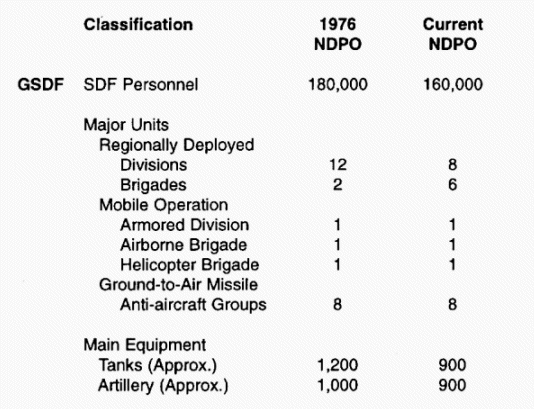





The largest of the three services, the Ground Self-Defense Force (GSDF), operates under the command of the chief of the ground staff, based in the city of Ichikawa, east of Tokyo.
Strategy is determined by the nation's elongated insular geography, its mountainous terrain, and the nearness of the Asian mainland. The terrain favors local defense against invasion by ground forces, but protection of the approximately 15,800-kilometer coastline of the four main islands would present unique problems in the event of a large-scale invasion. Potentially hostile aircraft and missile bases are so close that timely warning even by radar facilities might be difficult to obtain. Maneuver space is limited to such an extent that ground defenses would have to be virtually in place at the onset of hostilities. No point of the country is more than 150 kilometers from the sea. Moreover, the straits separating Honshu from the other main islands restrict the rapid movement of troops from one island to another, even though all major islands are now connected by bridges and tunnels. Within each island, mountain barriers and narrow roads restrict troop and supply movements. The key strategic region is densely populated and highly industrialized central Honshu, particularly the area from Tokyo to Kobe.
Japan has many places suited for landing operations and is geographically located close to neighboring countries on the continent. It is expected that an aggressor will attempt to assure the safety of its landing forces by concentrating its naval and air assets to secure overwhelming combat power at the time and on the point they choose. It is extremely difficult, or practically impossible, for Japan to have enough defense capability to repel all troops of an aggressor on the sea. It would incur enormous and unbearable costs to build up such defense capability. Consequently, we need to preserve an adequate ground defense capability to destroy those aggressor troops on the ground who have succeeded in their landing operation. A robust ground defense capability to repel an aggressor, which might succeed in breaking through our maritime defense, will enable us to maintain solid defense posture required for effective deterrence against an aggression.
Intended to deter attack, repulse a small invasion, or provide a holding action until reinforced by United States armed forces, the ground element is neither equipped nor staffed to offer more than a show of conventional defense by itself. Antitank artillery, ground-to-sea firepower, and mobility were improved and surface-to- ship missiles were acquired in the Mid-Term Defense Estimate completed in FY 1990. The number of uniformed personnel is insufficient to enable an immediate shift onto emergency footing. Instead, the ratio of officers to enlisted personnel is high, requiring augmentation by reserves or volunteers in times of crisis. In 1992, however, GSDF reserve personnel, numbering 46,000, had received little professional training.
Although allotted 180,000 slots for uniformed personnel, in 1992 the force was maintained at about 86 percent of that level (with approximately 156,000 personnel) because of funding constraints. The GSDF consists of one armored division, twelve infantry divisions, one airborne brigade, two combined brigades, four training brigades, one artillery brigade with two groups, two air defense brigades with three groups, one helicopter brigade with twenty-four squadrons, and two antitank helicopter platoons.
The GSDF is divided into five regional armies, each containing two to four divisions, antiaircraft artillery units, and support units. The largest, the Northern Army, is headquartered on Hokkaido, where population and geographic constraints are less limiting than elsewhere. It has four divisions and artillery, antiaircraft artillery, and engineering brigades. The Northeastern Army and the Eastern Army, headquartered in Sendai and Ichikawa, respectively, each has two divisions. The Central Army, headquartered in Itami, has three divisions in addition to a combined brigade located on Shikoku. The Western Army, with two divisions, is headquartered at Kengun and maintains a combined brigade on Okinawa.
The National Defense Program Outline which determines Japan's defense capabilities, was reviewed and newly established in December 1995. Through a review of the troop structure, the Self-Defense Personnel of the GSDF was reduced from the current 180,000 to 160,000. Some units may be staffed by new Self-Defense Force Reserve Personnel (Ready Reserve Personnel) capable of being quickly mobilized and to create a high-quality and effective system, will be established by 15,000 Ready Reserve Personnel, and 145,000 Regular Personnel. A fundamental review of the troop structure, previously consisting of 13 divisions and 2 combined brigades stationed nationwide, resulted in a balanced deployment of divisions and brigades uniquely suited to the local circumstances of the area where each unit is deployed. Present 4 divisions and 2 combined brigades will be reorganized into new brigades. According to the Outline, the GSDF planned to reduce the four divisions belonging to the Northern Army (two divisions), the Northeastern Army (one division), and the Middle Army (one division) into brigade size and mobilize them, while maintaining the two divisions belonging to the Western Army as they are and turning the First Mixed Group into a brigade.

In 1989 basic training for lower-secondary and upper-secondary school graduates began in the training brigade and lasted approximately three months. Specialized enlisted and noncommissioned officer (NCO) candidate courses were available in branch schools, and qualified NCOs could enter an eight-to-twelve- week second lieutenant candidate program. Senior NCOs and graduates of an eighty-week NCO pilot course were eligible to enter officer candidate schools, as were graduates of the National Defense Academy at Yokosuka and graduates of four-year universities. Advanced technical, flight, medical, and command staff officer courses were also run by the GSDF. Like the maritime and air forces, the GSDF ran a youth cadet program offering technical training to lower-secondary school graduates below military age in return for a promise of enlistment.
Because of population density on the Japanese islands, only limited areas were available for large-scale training, and, even in these areas, noise restrictions were a problem. The GSDF tried to adapt to these conditions by conducting command post exercises and map maneuvers and by using simulators and other training devices. In live firing during training, propellants were reduced to shorten shell ranges. Such restrictions diminished the value of combat training and troop morale.
